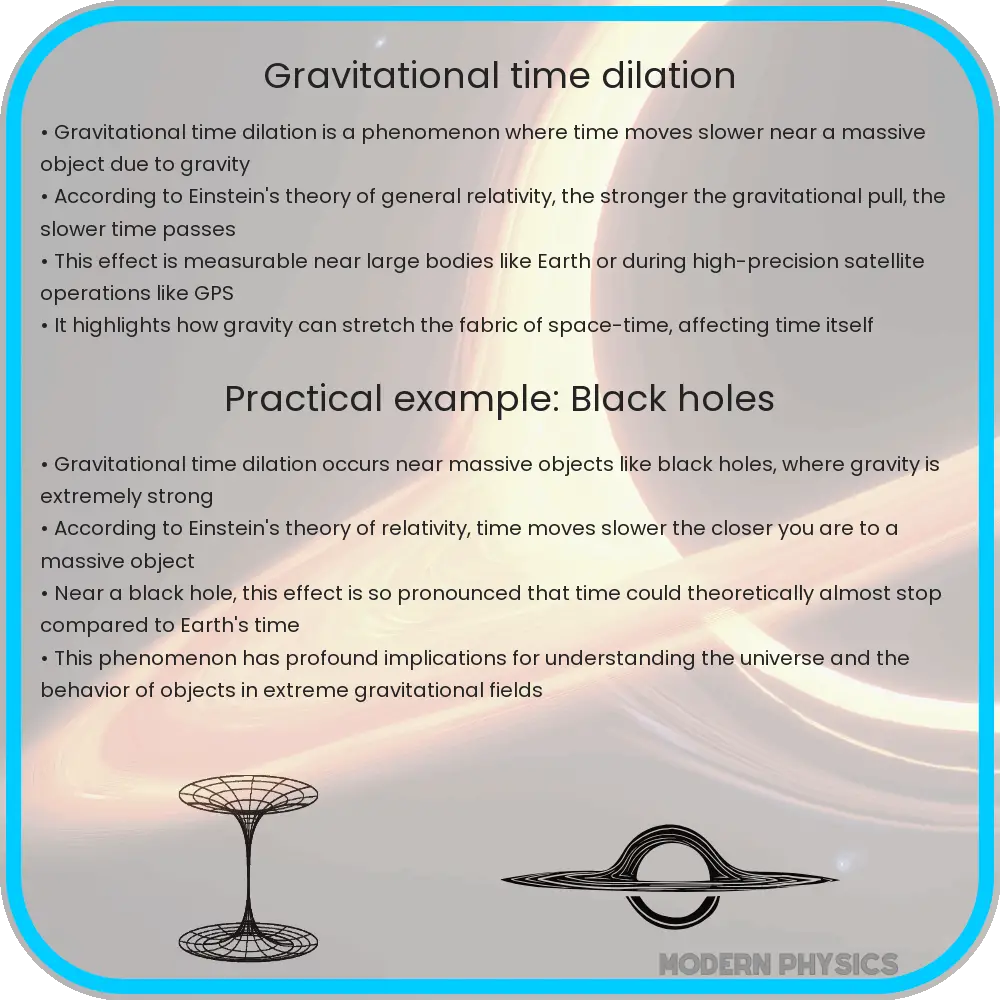Gravitational time dilation is how the presence of a massive object slows down time near it compared to farther away, as predicted by Einstein’s theory of general relativity.

Understanding Gravitational Time Dilation
One of the most fascinating predictions of Albert Einstein’s theory of general relativity is gravitational time dilation. This phenomenon occurs because the presence of a massive object will slow down the flow of time near it compared to time at a greater distance from the object.
Theory behind Gravitational Time Dilation
The theory of general relativity, published by Einstein in 1915, radically changed our understanding of gravity. The key idea is that gravity is not a conventional force but a curvature of spacetime caused by mass and energy. The more massive an object, the more it warps the fabric of space and time around itself. This warping affects the passage of time, a phenomenon evident under strong gravitational fields.
Mathematically, gravitational time dilation is described using the equation:
\[ \Delta t’ = \Delta t \sqrt{1 – \frac{2GM}{rc^2}} \]
where:
- \(\Delta t’\) is the time interval measured by an observer at a distance from a massive object,
- \(\Delta t\) is the proper time interval for an observer located far from the gravitational influence,
- G is the gravitational constant,
- M is the mass of the object creating the gravitational field,
- r is the radial coordinate (essentially the distance from the center of mass of the object), and
- c is the speed of light in vacuum.
Effects of Gravitational Time Dilation
While gravitational time dilation is highly pronounced near massive bodies like black holes or neutron stars, it is also present in everyday environments, albeit at much weaker levels. For instance, clocks on GPS satellites, orbiting Earth, experience both gravitational time dilation and the effects from special relativity due to their velocity relative to the surface of the Earth. The GPS system must account for these differences in time dilation to maintain accuracy in its navigation signals.
Another fascinating aspect of gravitational time dilation has been experimentally verified using precise timekeeping devices such as atomic clocks. Experiments have shown that clocks positioned at higher elevations (further from the center of Earth where gravitational pull is weaker) run faster compared to those at sea level.
Consider the famous Hafele-Keating experiment carried out in 1971, where atomic clocks were flown around the world on commercial airliners. The clocks moved at high speeds and at significant altitudes, both factors influencing their rate as predicted by both general and special relativity. When compared to clocks left at the departure airport, the differences in time were in direct correlation with relativistic predictions, thus supporting the theory of relativity.
In more extreme conditions, such as near a black hole, gravitational time dilation becomes even more dramatic. As depicted in popular science fiction movies like ‘Interstellar’, time can slow down significantly close to a black hole compared to farther away. If an astronaut were to orbit close to a black hole, many years could pass in the outside world while only a few hours pass for the astronaut.
This begs the question: What implications does gravitational time dilation have on our understanding of the universe? For one, it challenges our conception of time as a constant and universal measure. Additionally, understanding this relativistic effect is crucial for the fields of astrophysics, cosmology, and space travel.
Practical Implications and Future Directions
The principles of gravitational time dilation not only enhance our understanding of the universe but also have practical applications in technology and space exploration. Engineers and scientists must consider these time variations to ensure the accuracy of satellite communications and the functionality of space missions. As we plan for long-duration spaceflights, potentially to Mars or beyond, understanding and accounting for time dilation will be crucial for navigation and for synchronizing time between space travelers and Earth.
Moreover, this concept paves the way for future experiments aimed at testing the limits of general relativity under even more extreme conditions. Possible future endeavors could involve more precise measurements of time dilation effects around heavier celestial bodies or during high-speed space travel close to the speed of light.
Conclusion
Gravitational time dilation, a phenomenon formerly confined to theoretical discussions and esteemed scientific papers, is now recognized as a significant real-world factor requiring practical considerations in modern technology and space exploration. The formulation provided by Einstein’s theory of general relativity has not only stood the test of time through various experimental validations but continues to intrigue and challenge our understanding of the fundamental nature of time and space. As our technological capabilities expand, the principles of gravitational time dilation will play an even more pivotal role in shaping future scientific and engineering endeavors, illustrating the timeless relevance of Einstein’s insights into the fabric of the cosmos.
